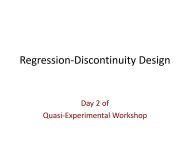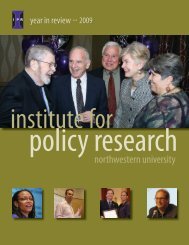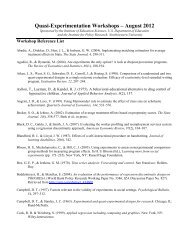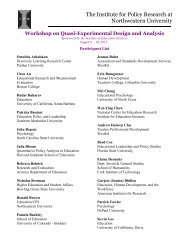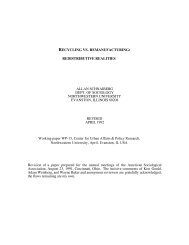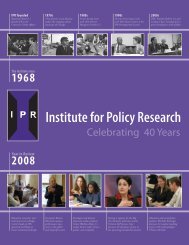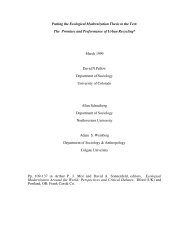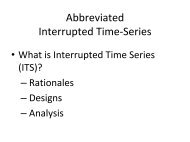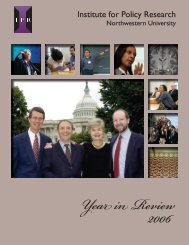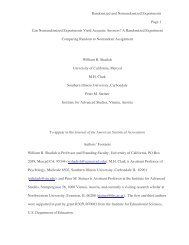Whatever Happened to the Emerging Democratic Majority?
Whatever Happened to the Emerging Democratic Majority?
Whatever Happened to the Emerging Democratic Majority?
Create successful ePaper yourself
Turn your PDF publications into a flip-book with our unique Google optimized e-Paper software.
J. Reblando<br />
9<br />
Inside <strong>the</strong> Black Box of Schools<br />
Policy briefing dissects research on classrooms, teachers,<br />
and school leaders<br />
Observers seem <strong>to</strong> have few problems in identifying lackluster<br />
student achievement in American schools. Yet pinpointing<br />
<strong>the</strong> school-level fac<strong>to</strong>rs that contribute <strong>to</strong> students’<br />
achievement—and avoiding those that do not—is difficult. At a<br />
February 4 IPR policy briefing, supported by a Joyce Foundation<br />
grant, a trio of experts<br />
delved in<strong>to</strong> <strong>the</strong> “black box”<br />
of schools, exploring <strong>the</strong><br />
impact of classroom size,<br />
teacher quality, and school<br />
leadership on school and<br />
student success.<br />
Evidence about<br />
school leaders<br />
Does school leadership<br />
have a direct effect on student<br />
achievement?<br />
Past studies of school<br />
leadership have found only<br />
small, mostly indirect, effects<br />
on student learning, noted<br />
IPR Faculty Fellow James<br />
Spillane, professor of human development, social policy, and<br />
learning sciences. But <strong>the</strong>se effects can account for up <strong>to</strong> 25<br />
percent of all variation explained by school-level variables, and<br />
tend <strong>to</strong> be stronger for <strong>the</strong> nation’s most troubled schools. The<br />
available evidence has its share of problems, especially when<br />
it comes <strong>to</strong> making causal claims. According <strong>to</strong> Spillane, <strong>the</strong>se<br />
problems are a function of both <strong>the</strong> research design and <strong>the</strong><br />
defi nition of school leadership.<br />
Having led <strong>the</strong> nation’s largest study on distributed<br />
leadership, which examines how school leadership is<br />
distributed among formally designated and informal leaders,<br />
Spillane pointed out that <strong>the</strong> principal’s job is <strong>to</strong>o big for one<br />
person. School principals are expected <strong>to</strong> work on three sets<br />
of organizational functions: setting direction for <strong>the</strong>ir school,<br />
managing teacher and staff development, and supporting <strong>the</strong><br />
school’s organizational structure and culture. Yet it “makes no<br />
sense” <strong>to</strong> expect just <strong>the</strong> principal, and perhaps <strong>the</strong> assistant<br />
principal, <strong>to</strong> accomplish all of <strong>the</strong>se tasks effectively, he said.<br />
“It’s not just that <strong>the</strong>re’s <strong>to</strong>o much <strong>to</strong> do. It’s that in order<br />
<strong>to</strong> do this job effectively, <strong>the</strong>re’s <strong>to</strong>o much <strong>to</strong> know for one<br />
person,” Spillane said. In fact, leadership involves many people<br />
in schools, including teachers. One recent study of 120 schools<br />
found between three and seven formally designated leaders<br />
per elementary school.<br />
The challenge is learning more about—and developing—<br />
leadership as a practice through evidence-based research. “We<br />
know a lot about processes, structure, and roles, but <strong>the</strong> how<br />
of leadership is not unders<strong>to</strong>od,” he emphasized.<br />
Evidence from <strong>the</strong> classroom<br />
IPR Faculty Associate Spyros Konstan<strong>to</strong>poulos, assistant<br />
professor of human development, social policy, and learning<br />
sciences, discussed class size and its effect on class<br />
achievement.<br />
From his study of <strong>the</strong><br />
state of Tennessee’s<br />
Project STAR* data,<br />
Konstan<strong>to</strong>poulos fi nds<br />
strong evidence <strong>to</strong><br />
support <strong>the</strong> idea that<br />
students in small classes<br />
do better than those in<br />
larger ones: Each year,<br />
<strong>the</strong>y tested higher in<br />
reading and math than<br />
<strong>the</strong>ir peers in larger<br />
classes.<br />
But <strong>the</strong> more pressing<br />
question, he points out,<br />
is whe<strong>the</strong>r <strong>the</strong> benefi ts<br />
of smaller class sizes<br />
persist over time and<br />
help <strong>the</strong> students beyond elementary school.<br />
It would seem so. From <strong>the</strong> results of a follow-up study,<br />
Konstan<strong>to</strong>poulos demonstrated that <strong>the</strong> students, including<br />
minority students, were more prepared <strong>to</strong> take standardized<br />
college tests and scored higher. This, in turn, gives <strong>the</strong>m a higher<br />
probability of being admitted <strong>to</strong>—and attending—college.<br />
While encouraging, more work remains <strong>to</strong> be done on issues<br />
such as whe<strong>the</strong>r small classes are cost effective and how much<br />
<strong>the</strong>y can help <strong>to</strong> close <strong>the</strong> racial achievement gap, he said.<br />
James Spillane discusses distributed leadership<br />
in schools with an attendee.<br />
*Project STAR (Student Teacher Achievement Ratio) was a $12<br />
million large-scale, four-year randomized experiment, covering<br />
11,000 students in 79 Tennessee schools.<br />
Web site: www.heros-inc.org/star.<br />
Evidence about teachers<br />
Economist Kim Rueben considered whe<strong>the</strong>r teachers matter<br />
and whe<strong>the</strong>r <strong>the</strong>ir performance can affect student achievement.<br />
Rueben is a senior research associate at <strong>the</strong> Urban Institute<br />
in Washing<strong>to</strong>n, D.C.<br />
“This seems like it should almost be a no-brainer,” she said.<br />
“Of course, teachers matter. If you are a parent or a principal,<br />
you know <strong>the</strong>re are good teachers and bad teachers in your<br />
school. You know you want your kids in certain classrooms<br />
and not o<strong>the</strong>rs.”<br />
But it is extremely difficult <strong>to</strong> identify <strong>the</strong> indica<strong>to</strong>rs that will<br />
reveal which teachers are going <strong>to</strong> be more effective, Rueben<br />
said.<br />
(continued on page 21)



